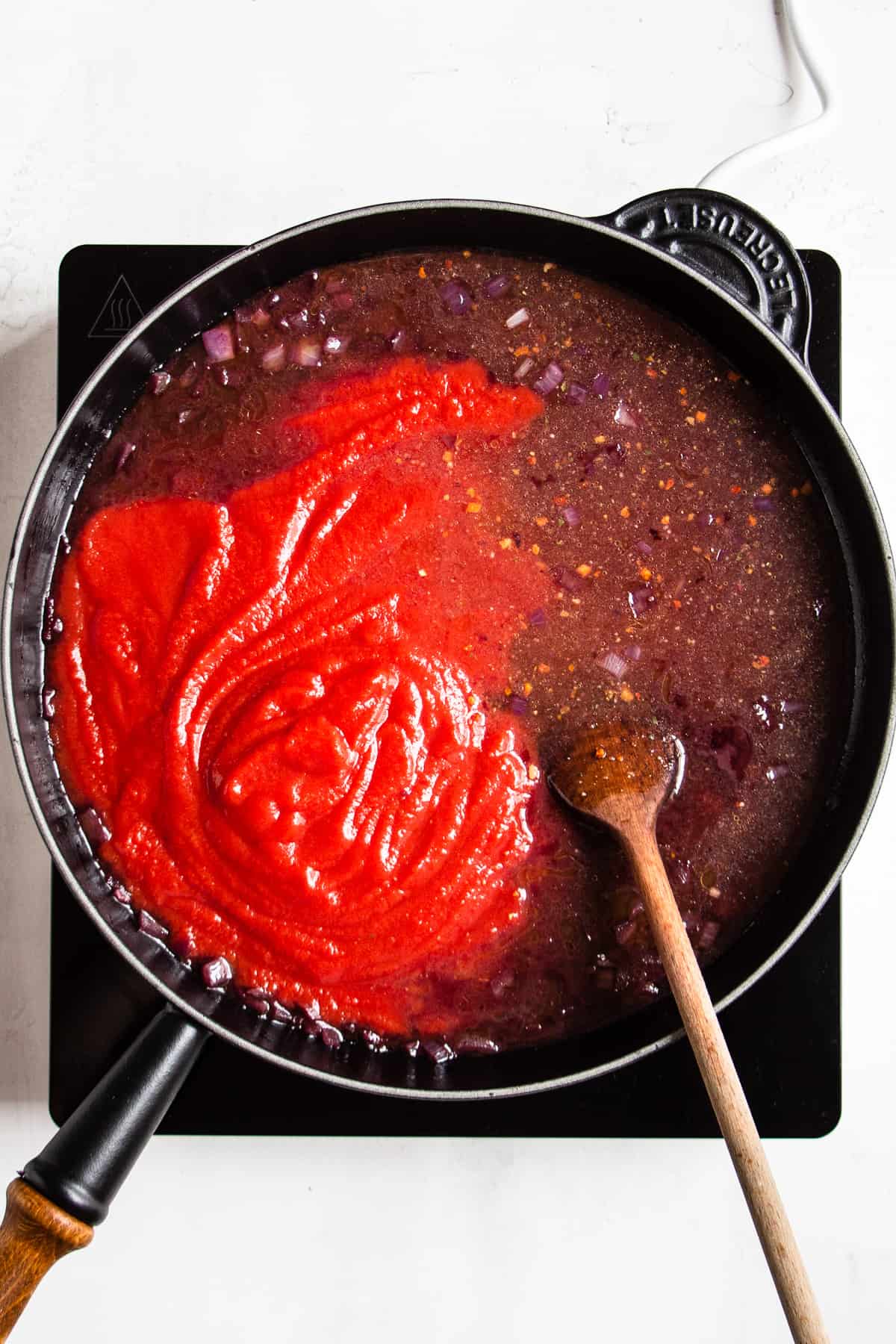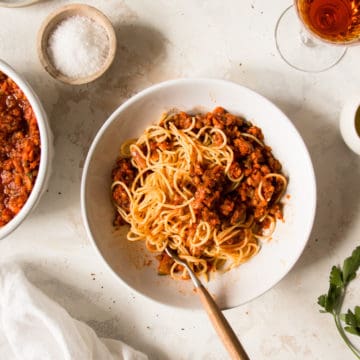This recipe makes a simple pasta sauce with passata taste like an authentic Italian tomato sauce. Add garlic, onions, and a splash of red wine to some tomato puree and let it simmer. You can make this sauce for dinner in less than 30 minutes!

Passata di Pomodoro is one of the bases of Italian cuisine. This easy recipe made with a handful of ingredients is one of the weeknight meals I rotate through when I'm short on time. It requires little effort but tastes incredibly delicious.
If you're looking for more simple sauce recipes, check out this pasta sauce with tomato paste or this tomato sauce from canned tomatoes. You may also like my vegan vodka sauce, vegan lentil bolognese or cauliflower bolognese.
Jump to:
Key ingredients and substitutions

- Onion and garlic are the perfect aromatics for a tomato sauce.
- Tomato passata, also known as tomato puree is the base of this recipe. Look for a brand of tomato passata that only uses fresh tomatoes and eventually salt (no other additives or flavorings). You can find it in a glass bottle, a tall glass jar or a carton at most grocery stores. I like Italian brands like Mutti, DeLallo and Pomi.
- Red wine adds flavor and depth. It's the secret ingredient that turns boring passata into a delicious spaghetti sauce.
- Vegetable broth is needed for extra flavor and the perfect consistency.
- Italian seasoning will add that Italian touch that we all love. It's usually made of dried oregano, dried basil and a bunch of other herbs.
- Fresh basil and thyme make the best garnish.
See recipe card for detailed measurements and instructions.
Tomato passata/puree vs other tomato products
Tomato paste is more concentrated than tomato puree. It has been reduced twice and, as the name reveals, has the thick consistency of a paste. Tomato puree has are more liquid consistency, similar to a blended sauce.
Both are made from cooked and strained tomatoes. The difference lies in their consistency with tomato sauce being thinner than tomato puree. Furthermore, while tomato puree is purely made from tomatoes and maybe a pinch of salt, tomato sauce often contains other aromatics like onion, garlic and herbs.
Crushed tomatoes have been cooked but not strained. As a result, they contain chunks and are more watery than tomato puree. Tomato puree is perfectly smooth and slightly thicker.
What is the best red wine for cooking?
I always try to find a wine that's affordable enough to cook with but good enough to drink (especially because we only need a small amount for this quick tomato sauce). Avoid cheap "cooking wines" if you can.
Choose a red wine with a moderate tannin content, as the heat will accentuate it. Merlot, Pinot Noir and light Carbernet Sauvignons are great choices.
Elo's tips
- Look for the letter A on your bottle, can or carton of tomato passata. The A grade warrants that the product is made with high-quality tomatoes. It guarantees good taste, odor, color and makes sure the passata is practically free from defects (USDA).
- Cook your pasta in a LARGE pot with salted water.
- Drain your pasta when they are al dente.
Step-by-step instructions

STEP 1: Mince the onion and garlic. I like to use a garlic press for the garlic.

STEP 2: Heat a large pan or Dutch oven with a little olive oil. Sauté the onion and garlic until soft and fragrant over medium-high heat. This should take 2-3 minutes.

STEP 3: Pour the red wine into the pan. Let it reduce by half over medium-high heat while stirring regularly. This should take about 5 minutes and allow most of the alcohol to cook off.

STEP 4: Add the passata and a pinch of sugar once the wine has reduced. Give it a good stir and let the sauce simmer over medium heat for 10 to 15 minutes. In the meantime, cook your favorite pasta according to the package directions.

STEP 5: Season the sauce with salt, pepper and your favorite Italian seasoning mix. You can also add red chilli flakes if you like it spicy. Mine has dried oregano, basil and some dried tomatoes.

STEP 6: Swirl the pasta in the sauce until well-covered. Serve with fresh basil and thyme for extra flavor.
Watch the video!
How to use this sauce
Use this sauce like a marinara. You can let it simmer a little longer if you like a thicker consistency. You can use it in various pasta dishes but also:
- In a lasagna
- As a pizza sauce
- With sauteed Mediterranean vegetables
- With zucchini boats or butternut squash boats
- With vegetable noodles such as zucchini or sweet potato swirls
- With vegan meatballs
Storage tips
If you made a few extra servings of sauce or have leftovers, transfer them to an airtight container or freezer bag. You can store it in the fridge for up to 3-4 days or in the freezer for 3 months.

Frequently asked questions
It's always preferable to use passata as it already has a thick and smooth consistency. However, you could substitute it for the same amount of canned crushed tomatoes and let the sauce simmer twice as long to obtain a similar result.
Some passata brands are more acidic than others and some wines are pretty acidic, too. If that's the case, simply add another pinch of sugar to balance it out.
Don’t forget to join the Cooking With Elo newsletter. You’ll get gluten-free and vegan dinner ideas sent right to your inbox.
The recipe

Pasta Sauce With Passata (Tomato Puree)
Ingredients
- 4 servings of pasta gluten-free
- 1 onion
- 2 cloves of garlic
- 2 tablespoons olive oil
- ½ cup (120 ml) red wine
- 28 oz (800 ml) passata also known as tomato puree
- 1 cup (240 ml) vegetable broth
- ½ teaspoon sugar
- 1-2 teaspoons Italian seasoning
- 1 pinch of salt and pepper
- Fresh basil
Instructions
- Finely mince the onion and garlic.
- In a large pan or skillet with olive oil, sauté the onion and garlic over medium-high heat until fragrant.
- Pour in the red wine and allow it to reduce by half. It should take about 5 minutes.
- Bring salted water to a boil. Cook the pasta according to package directions.
- Add the passata, vegetable broth, sugar, Italian seasoning, salt and pepper to the pan with the onions. Let it simmer over medium heat for 10-15 minutes, while the pasta cooks.
- When the pasta is done, swirl it around the pan until covered in sauce. Serve with fresh basil.
Video
Notes
- One serving of pasta equals 2-3 ounces (60-85 g).
Nutrition
Leave a star rating and review below. Thank you!
More pasta sauce recipes
Loved it? Please rate it!
If you tried this recipe or any other recipe from the blog, make sure to let me know how you liked it by leaving a star rating and a comment below. Your feedback really matters! To never miss a recipe, follow me on Instragram, Pinterest and Facebook.












Calls for vegetable broth, yet it’s not mentioned in the recipe.
Thank you so much for pointing that out! I corrected in it the instructions 😊 As shown in the video, the vegetable broth is added at the same time as the tomato passata.